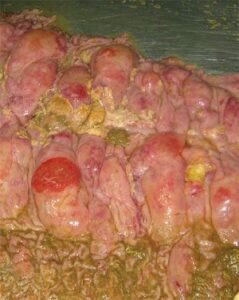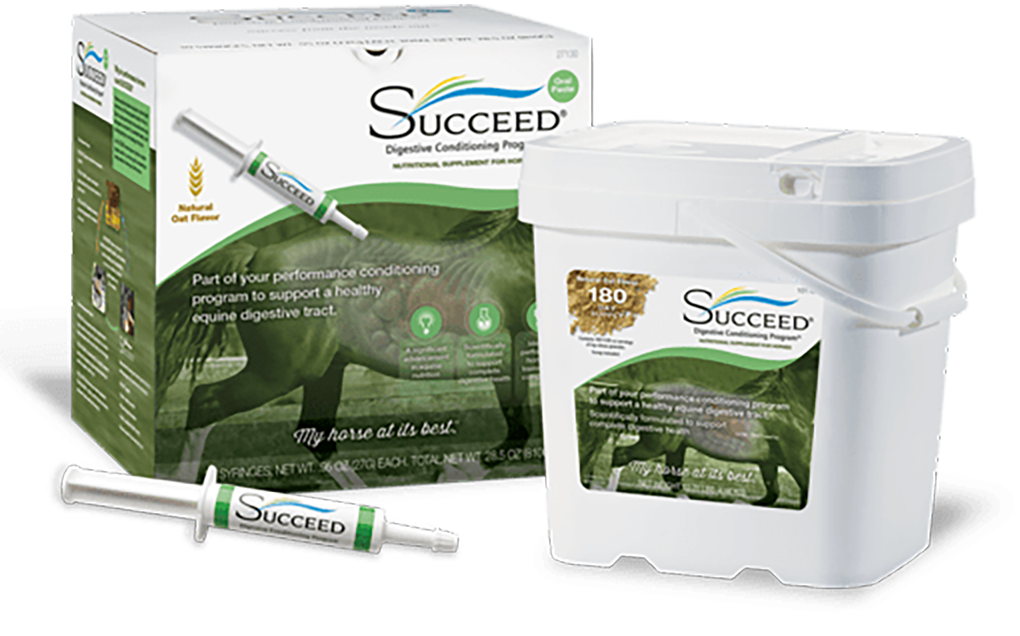by Emma Hardy, PhD
published in December 2009/January 2010 issue of Horse Health magazine
NO matter how healthy your horse looks on the outside, if it is in training and regularly competing, research suggests that it is likely to be suffering from ulcers. Indeed, prevalence of gastric ulcers has been reported in as much as 97 per cent of racehorses, 50 to 60 per cent of dressage horses, show-jumpers and hunters, and even in as many as 37 per cent of leisure horses.
Aetiology, diagnosis and therapeutic strategies for gastric ulcers have become well established in recent years; however the prevalence and impact of hindgut ulceration has been frequently overlooked and is largely misunderstood.
Colonic ulceration manifests in several ways, ranging from adverse changes in temperament and performance, to loss of weight, condition and appetite, bouts of colic and subclinical anaemia. Furthermore, hindgut discomfort may even be expressed as a reluctance of the horse to extend, collect or flex through the body. These symptoms can all be attributed to the discomfort and inefficient digestion and absorption which accompany colonic ulcers.

So,why is diagnosis of colonic ulcers frequently missed?
A three metre endoscope can onlyvisualise the foregut, and colonoscopy in the horse is not only highly invasive and but also carries a significant risk of death. Thickening of the colon wall, as occurs with colonic ulcers can sometimes be identified by ultrasound but this can be difficult to interpret. As a consequence, previous diagnosis of colonic ulceration has largely been limited to necropsy.
A large-scale study of 180 performance horse cadavers completed in 2003 by Dr Pellegrini, revealed that almost 90 per cent had gastric ulcers and over 60 per cent had colonic ulcers, with an overall ulceration rate of 97 per cent.
There is also evidence for colonic ulceration in live horses; Dr Diana Hassel, assistant professor of equine emergency surgery at Colorado State University, found that during emergency surgery gastric ulceration was frequently accompanied bycolonic ulceration. The prevalence of colonic ulcers maybe slightly lower than gastric ulcers,but as Dr Frank Andrews, director of the equine health studies program at Louisiana State University points out, they may lead to more severe clinical issues and hypoproteinaemia (low protein uptake).
Clearly differential diagnosis is crucial in order to determine the most appropriate treatment strategy, particularly when standard drug treatments for gastric ulcers which limit acid secretion, are completely useless in the hindgut. Recently, a new, non-invasive ‘ELISA’ based test has been developed to aid diagnosis of intestinal conditions in a way that until now was not possible.
So why do horses get colonic ulcers?
In evolutionary terms horses are nomadic trickle feeders; a lifestyle often contrary to the performance horse, which is subjected to prolonged stabling and intermittent feeding. However, in order for the performance horse to meet the demands of competition this lifestyle is considered necessary. In the horse, gastric acid secretion is continuous, which not only leaves the stomach lining vulnerable to damage when little food is present but can also lead to bolting of feed, and in turn increased gastric emptying when feed is offered.
When combined with the typical diet of the performance horse, incorporating high volumes of soluble carbohydrate and limited fibrous carbohydrate further complications arise. This type of diet increases secretion of gastric acid, rate of gastric emptying and reduces the volume of saliva produced to naturally buffer gastric acid.
As a consequence, enzymatic digestion in the stomach and small intestine is limited, with undigested feed ultimately reaching the site of microbial digestion; the cecum and colon. Micro-organisms in hindgut convert a portion of this type of carbohydrate into lactic acid, which can lead to a condition called Hindgut Acidosis. From this, detrimental changes to the gut microflora occur, withgrowth of pathogenic bacteria colonizing compromised areas (suchas the pits left by parasites) and eroding the lining of the colon. Lysis of beneficial bacteria releases damaging endotoxins, which if absorbed can result in colic, diarrheoa and laminitis.
Indeed, in a study by the Japanese Racing Association in 2002 endotoxins were injected into the artery feeding the hindgut and anterior portion of the small intestine, and subsequently induced colic. Other factors such as stress limit prostaglandin E activity, stimulating gastric acid secretion whilst inhibiting gastrointestinal blood flow and mucus production. Intensive training can also reduce blood flow to the gastrointestinal tract, depress appetite and strip the horse of important amino acids needed forcell regeneration, such as glutamine.
Stereotypies have frequently been associated with ulceration, although whether they are a cause or an effect is an ongoing debate, and prolonged use of NSAIDS and parasitic damage are also strongly implicated.
Importance of Digestive Health
In summary, for the horse to perform to its maximum potential an energy dense diet, stabling and intensive training are all considered necessary. Under these circumstances digestive health is paramount, particularly considering that all biological systems rely on efficient nutrient ultilsation to function properly.
A healthy digestive system enables optimal ingestion, digestion and absorption and allows the horse to meet and indeed exceed, the demands placed upon it.

Is SUCCEED right for you?
Find out if your horse’s health and performance could benefit from added digestive support.
